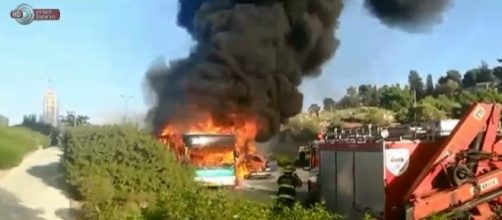Monday's bus bombing in Jerusalem (April 19th) was plagued with questions from the start: mechanical failure or terrorist attack? Lone terrorist or terror organization? Was the most critically injured unidentified individual inside the bus or outside, between the two buses? When the terrorist's identity was confirmed, was the father truly unaware of his son's affiliation with Hamas or was he complicit?
Hamas members arrested in Jerusalem bus bombing case:https://t.co/mmZtiARDgv pic.twitter.com/1MuLnC53Sp
— Ynetnews (@ynetnews) April 21, 2016
The first reports coming from the bomb site were quite inconclusive.
It took some time before the public heard confirmation that it was a terrorist attack. We knew from the beginning that over 16 people were injured, one seriously, perhaps fatally. That final number of injured climbed to 21.
Confirmed Terror Attack
There was talk, at first, about the alleged terrorist having stood between the two buses that burned, with the explosives having been placed in an empty bus, implying that the terrorist did not intend to be killed but was trying to get away and the bomb went off early. A bomb in an empty bus does not make sense in Israel because drivers always check their buses after the last passenger disembarks and again before starting along their route.
It later became clear that the terrorist sat in the last seat and the bomb was on the floor between his legs.
That makes sense, because his legs were blown off. Since the gas tank is at the back of the bus (he probably knew that), the bomb caused the bus to ignite and a bus (that one was empty) and car, close enough to go up in flames as well, were totally destroyed.
The bomb was made from acetone and related chemicals and it appears that its main impact was the fire it caused. It was a simple and relatively weak bomb in and of itself.
Terrorist identified after death
The unidentified man in critical condition in the hospital was always assumed to be the bomber. He died on Wednesday (April 21). Apparently his father had reported him missing when he did not come home Monday night. It is not clear if this was the break needed to begin an investigation into the identity of the terrorist and his assistants.
It was clear that the bombing relied on a terror infrastructure to carry out.
On Tuesday, a number of residents of Bet Jala, near Bethlehem, were taken into custody under suspicion of having taken part in the bombing. Mohammed Abu Srour was among them. It is not clear if he is suspected of having played a part in the bombing or if he was merely there to provide a DNA sample with which to identify the corpse, his son Abdel Hamid Abu Srour (19), otherwise burned beyond recognition. An uncle claimed that none of the young people in the extended family are allowed to carry their identity cards with them as a measure preventing them from leaving the region.
Innocent? Taken in for questioning or only for DNA tests to confirm identity of bomber? IBA news screenshot. pic.twitter.com/WH8tdoEPxj
— Sheri Oz (@sheri_oz) April 22, 2016
In an Israel news broadcast, Abu Srour's father claimed that they are a normal family and he knows nothing about his son's alleged terrorist activities or plans.
However, a few days before his death, Abu Srour gave his mother a photo of himself donning a Hamas scarf. Additionally, his Facebook timeline hinted at intentions to strike out against Israelis.
Hamas claimed him as "one of its sons" and praised his action, but did not immediately take responsibility. They are trying to contain the level of violence in order not to provoke another out and out war with Israel.
Abu Srour was raised in a wealthy family and his future was secure. He does not fit the profile politicians in the West are claiming turn Palestinian Arabs into terrorists; in fact, it is well known in Israel that most of the terrorists are from middle class families and either intend to pursue academic studies or are already at university.
Handing out sweets in PA after terror attack against Jews, again! IBA news screenshot. pic.twitter.com/jHSuvaVZFu
— Sheri Oz (@sheri_oz) April 22, 2016

